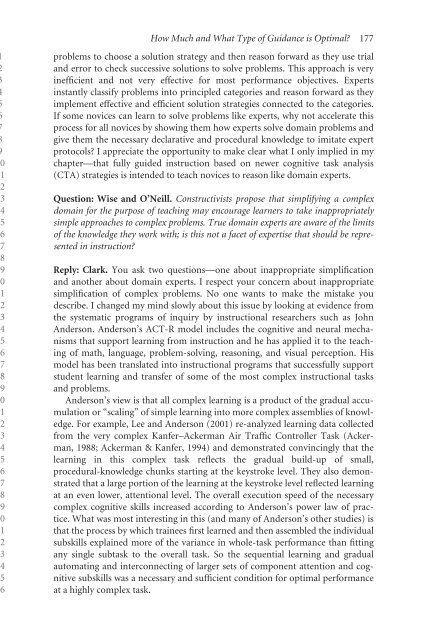9 How Much and What Type of Guidance is Optimal for Learning ...
9 How Much and What Type of Guidance is Optimal for Learning ...
9 How Much and What Type of Guidance is Optimal for Learning ...
You also want an ePaper? Increase the reach of your titles
YUMPU automatically turns print PDFs into web optimized ePapers that Google loves.
<strong>How</strong> <strong>Much</strong> <strong>and</strong> <strong>What</strong> <strong>Type</strong> <strong>of</strong> <strong>Guidance</strong> <strong>is</strong> <strong>Optimal</strong>? 1770123456789012345678901234567890123456problems to choose a solution strategy <strong>and</strong> then reason <strong>for</strong>ward as they use trial<strong>and</strong> error to check successive solutions to solve problems. Th<strong>is</strong> approach <strong>is</strong> veryinefficient <strong>and</strong> not very effective <strong>for</strong> most per<strong>for</strong>mance objectives. Expertsinstantly classify problems into principled categories <strong>and</strong> reason <strong>for</strong>ward as theyimplement effective <strong>and</strong> efficient solution strategies connected to the categories.If some novices can learn to solve problems like experts, why not accelerate th<strong>is</strong>process <strong>for</strong> all novices by showing them how experts solve domain problems <strong>and</strong>give them the necessary declarative <strong>and</strong> procedural knowledge to imitate expertprotocols? I appreciate the opportunity to make clear what I only implied in mychapter—that fully guided instruction based on newer cognitive task analys<strong>is</strong>(CTA) strategies <strong>is</strong> intended to teach novices to reason like domain experts.Question: W<strong>is</strong>e <strong>and</strong> O’Neill. Constructiv<strong>is</strong>ts propose that simplifying a complexdomain <strong>for</strong> the purpose <strong>of</strong> teaching may encourage learners to take inappropriatelysimple approaches to complex problems. True domain experts are aware <strong>of</strong> the limits<strong>of</strong> the knowledge they work with; <strong>is</strong> th<strong>is</strong> not a facet <strong>of</strong> expert<strong>is</strong>e that should be representedin instruction?Reply: Clark. You ask two questions—one about inappropriate simplification<strong>and</strong> another about domain experts. I respect your concern about inappropriatesimplification <strong>of</strong> complex problems. No one wants to make the m<strong>is</strong>take youdescribe. I changed my mind slowly about th<strong>is</strong> <strong>is</strong>sue by looking at evidence fromthe systematic programs <strong>of</strong> inquiry by instructional researchers such as JohnAnderson. Anderson’s ACT- R model includes the cognitive <strong>and</strong> neural mechan<strong>is</strong>msthat support learning from instruction <strong>and</strong> he has applied it to the teaching<strong>of</strong> math, language, problem- solving, reasoning, <strong>and</strong> v<strong>is</strong>ual perception. H<strong>is</strong>model has been translated into instructional programs that successfully supportstudent learning <strong>and</strong> transfer <strong>of</strong> some <strong>of</strong> the most complex instructional tasks<strong>and</strong> problems.Anderson’s view <strong>is</strong> that all complex learning <strong>is</strong> a product <strong>of</strong> the gradual accumulationor “scaling” <strong>of</strong> simple learning into more complex assemblies <strong>of</strong> knowledge.For example, Lee <strong>and</strong> Anderson (2001) re- analyzed learning data collectedfrom the very complex Kanfer–Ackerman Air Traffic Controller Task (Ackerman,1988; Ackerman & Kanfer, 1994) <strong>and</strong> demonstrated convincingly that thelearning in th<strong>is</strong> complex task reflects the gradual build- up <strong>of</strong> small,procedural- knowledge chunks starting at the keystroke level. They also demonstratedthat a large portion <strong>of</strong> the learning at the keystroke level reflected learningat an even lower, attentional level. The overall execution speed <strong>of</strong> the necessarycomplex cognitive skills increased according to Anderson’s power law <strong>of</strong> practice.<strong>What</strong> was most interesting in th<strong>is</strong> (<strong>and</strong> many <strong>of</strong> Anderson’s other studies) <strong>is</strong>that the process by which trainees first learned <strong>and</strong> then assembled the individualsubskills explained more <strong>of</strong> the variance in whole- task per<strong>for</strong>mance than fittingany single subtask to the overall task. So the sequential learning <strong>and</strong> gradualautomating <strong>and</strong> interconnecting <strong>of</strong> larger sets <strong>of</strong> component attention <strong>and</strong> cognitivesubskills was a necessary <strong>and</strong> sufficient condition <strong>for</strong> optimal per<strong>for</strong>manceat a highly complex task.
















